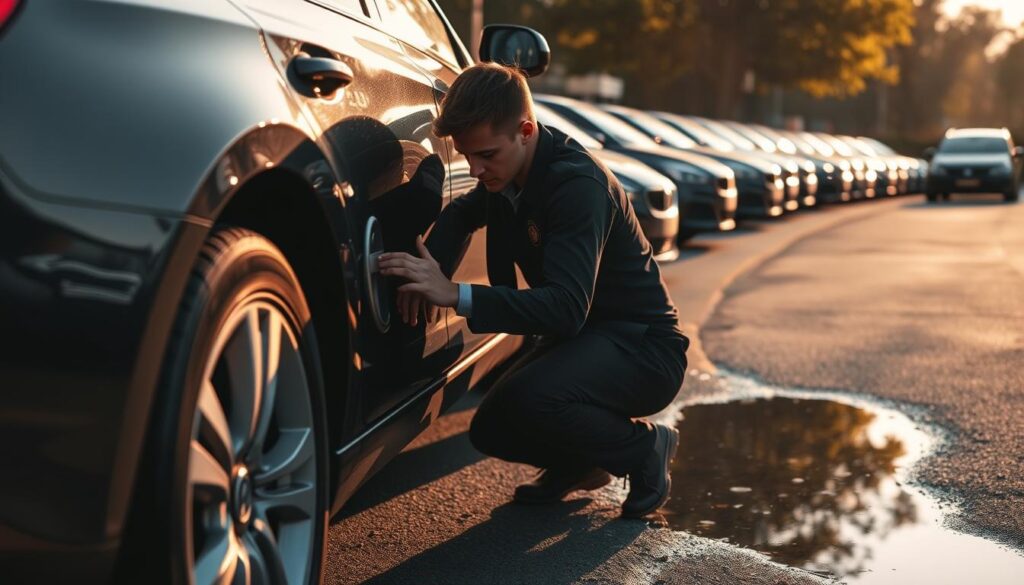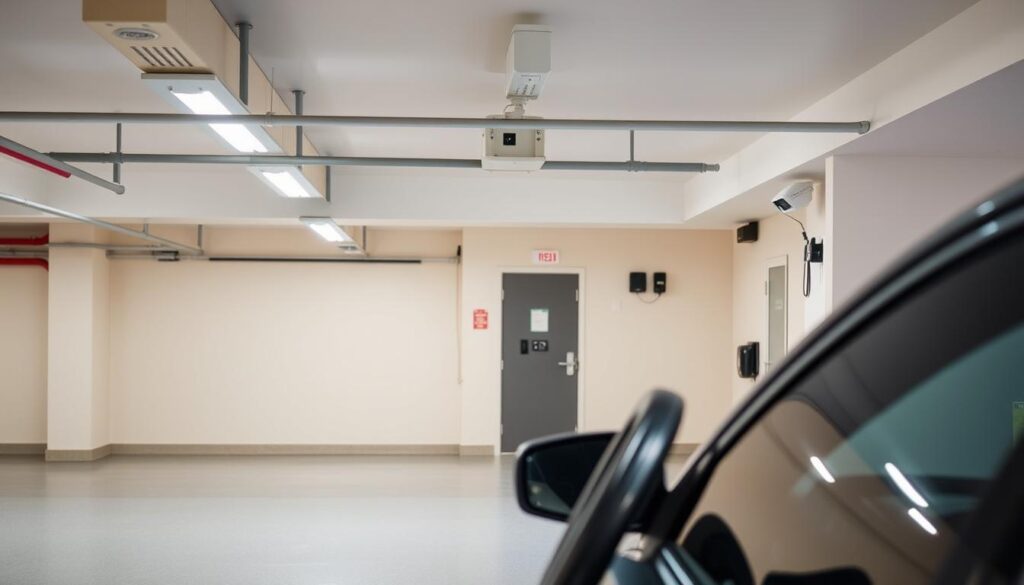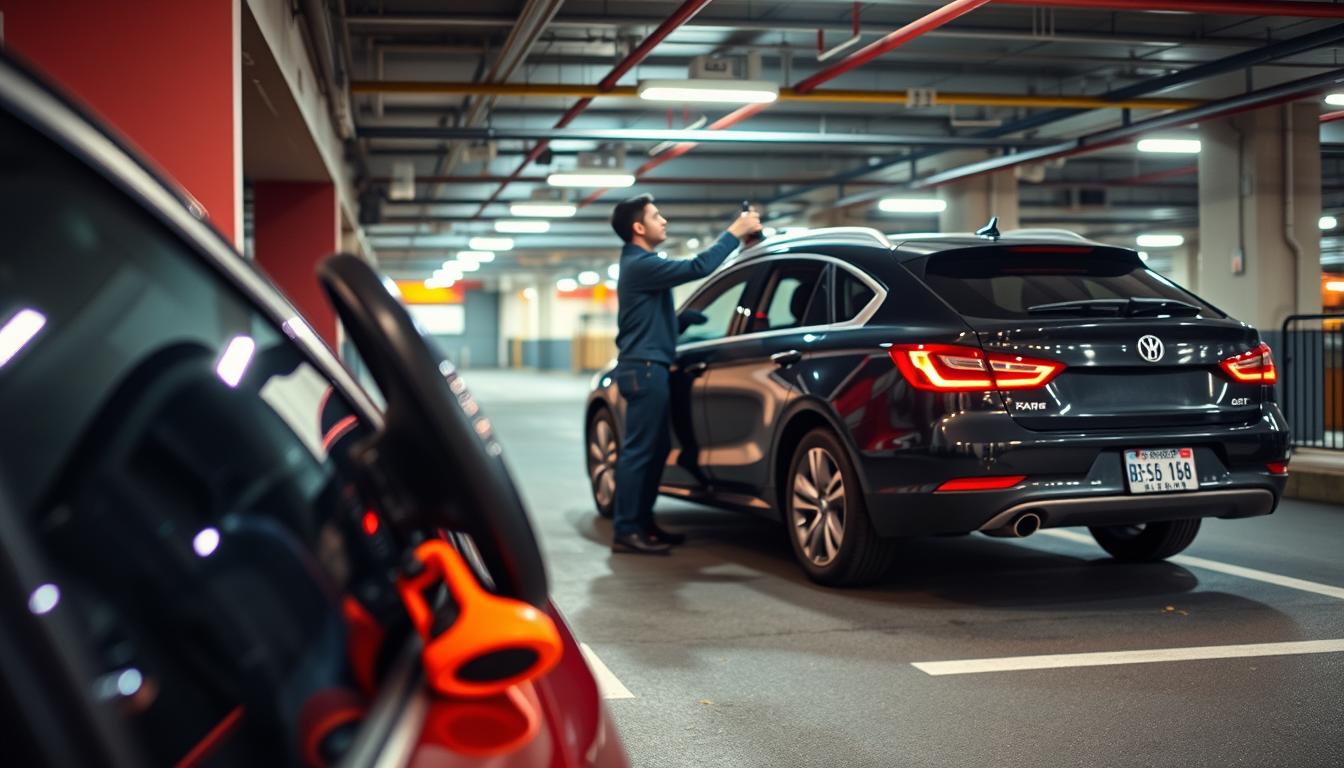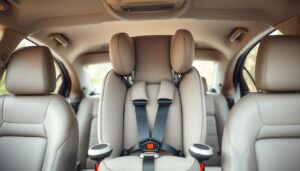How to Prevent Car Theft
Imagine this: in the time it takes to read this sentence, a vehicle was just stolen. Every 39 seconds, another automobile disappears in the United States.
This adds up to nearly 800,000 vehicles each year, with losses soaring over $6 billion. These numbers are staggering, but here’s the most important part. Experts report that 40-50% of these incidents are due to simple driver mistakes.
Leaving doors unlocked or keys inside an unattended vehicle turns your car into an easy target. The good news is that this means prevention is largely in your hands.
Thieves typically look for the path of least resistance. Anything you do to make your vehicle a harder target can significantly reduce your risk. This guide will walk you through simple, effective strategies.
Many of these methods require minimal effort and no extra cost. It’s about building smart habits to protect your property.
Key Takeaways
- A motor vehicle is stolen in the U.S. every 39 seconds.
- Driver error is a factor in nearly half of all auto thefts.
- Simple habits, like locking doors, are powerful deterrents.
- Thieves prefer easy targets; increasing difficulty discourages them.
- Effective vehicle security often requires little to no expense.
- Consistency is key to making prevention strategies work.
Understanding Car Theft Trends and Statistics

The landscape of vehicle crime has shifted dramatically in recent years. Knowing the current data helps you understand where risks are highest.
National and Local Theft Data
Some regions are seeing alarming spikes. Washington state reported an 88% jump in auto thefts in early 2022. New Jersey saw a 31% increase.
Contrary to what many believe, your own driveway might be the riskiest spot. A significant number of these incidents happen at or near the owner’s home.
The Impact of the Pandemic and Modern Technology
Remote work patterns changed everything. More automobiles sat unattended on residential streets, creating new opportunities for thieves.
Older, common models are top targets. Thieves seek vehicles like the 2000 Honda Civic or 2006 Ford pickup. Their parts are in high demand, making them profitable.
Modern tech brings new risks. Keyless entry systems can be hacked. Some criminals even use tracking devices to mark a target for later theft.
Supply chain issues have also played a role. With fewer new vehicles available, the value of stolen ones and their components has risen.
Identifying Vulnerable Areas & Common Car Theft Methods

Your daily parking routine might be creating opportunities for criminals you haven’t considered. Understanding who these thieves are and how they operate is the first step to making your automobile a less appealing target.
Risks in Different Parking Locations
Many people feel safest parking on their own street. Surprisingly, this can be a high-risk area. A thief prefers the cover of a familiar, quiet neighborhood.
Isolated spots in large lots or dimly lit garages are also prime targets. These locations offer privacy for a quick break-in. A busy, well-lit parking area is a strong natural deterrent.
Criminals often watch a location to learn patterns. They notice who leaves their doors unlocked or valuables in plain sight.
Thieves’ Techniques and Tactics
Not all thieves are the same. They generally fall into three categories:
- Professional thieves: These individuals work for organized rings. They often steal specific models for parts or export.
- Opportunistic joy-riders: They seek a thrill and often target high-performance cars. These vehicles are usually recovered, but often damaged.
- Desperate individuals: They are looking for a quick score, often taking whatever is easily accessible inside an unlocked vehicle.
One dangerous technique is the “bump-and-rob.” A thief bumps your vehicle from behind. When you get out to check for damage, they steal your automobile.
The most common method is simple opportunity. A criminal walks down a street, checking door handles. If a door is unlocked, they are inside and gone with your belongings in under 30 seconds.
Practical Vehicle Security Measures
The most powerful security for your automobile starts with simple, daily habits. These fundamental actions create significant barriers for any potential criminal.
Locking Doors, Windows, and Removing Keys
Make it a non-negotiable rule to lock your vehicle doors every single time you exit. This applies even in your own driveway or garage. An unlocked door is the easiest invitation for a thief.
Always take your key with you. Never leave it in the ignition or console. A shocking 229,339 vehicles were stolen in a recent two-year period because owners left keys or fobs inside.
Ensure all windows are completely rolled up. Even a small gap can give someone the space they need to unlock a door from the inside.
Simple Daily Precautions to Deter Thieves
Keep the interior of your car spotless. A thief does “window shopping.” Items like spare change, sunglasses, or an empty bag can attract unwanted attention.
Stow all valuables in the trunk before you arrive at your destination. If a criminal sees you hiding things, it defeats the purpose. This “out of sight, out of mind” approach is a powerful way to prevent car break-ins.
Turn these steps into automatic habits. Consistency is your greatest ally in keeping your vehicle safe.
How to Prevent Car Theft

Developing an automatic checklist can transform your vehicle protection strategy. Consistent routines create powerful barriers against potential thieves.
Routine Checks and Maintenance
Consider having your VIN etched onto all windows. This theft prevention method makes your automobile much less attractive to criminals. They would need to replace every piece of glass to resell it.
Never store your registration or title inside the vehicle. Thieves can use these documents if stopped by police. Keep them in your wallet or on your smartphone instead.
Building these habits into your daily routine ensures continuous protection. Consistency is the key to effective security measures.
Quick Prevention Tips Before Leaving Your Vehicle
Create a mental checklist for every parking situation. Verify doors are locked, windows are up, and keys are with you. Engage your alarm system if you have one.
When parking on hills, turn wheels toward the curb. Leave the transmission in park or gear. This simple step makes tow truck theft much more difficult.
Stow valuable items in the trunk before reaching your destination. Thieves often watch parking lots for people hiding belongings. Doing this early removes the opportunity.
Always scan your surroundings when exiting your automobile. Note any suspicious activity and consider moving if something feels wrong. Awareness is a powerful deterrent.
Implementing Advanced Anti-Theft Technologies

Beyond locking doors, a new generation of anti-theft systems provides robust protection for your automobile. These electronic solutions create significant hurdles for criminals.
Many insurers offer discounts for vehicles equipped with approved security systems. This makes the investment financially sensible over time.
Installing Alarm Systems and Immobilizers
Modern alarm systems often feature passive activation. They engage automatically when you remove the key, deterring thieves with loud sounds and lights.
Ignition immobilizers have been standard for decades. They prevent hot-wiring by requiring a unique code from your key fob. Without the correct signal, the engine will not start.
For an extra layer, consider an ignition cut-off system. It physically blocks the engine from starting, even if someone gains entry.
Utilizing GPS Tracking and Vehicle Recovery Systems
GPS tracking technology is a game-changer. It uses cellular and satellite data to help police locate stolen vehicles quickly.
Many new cars have built-in recovery systems. For older models, companies like Tag offer professional installation of tracking devices.
Some manufacturers, like Audi, add discrete, permanent tracking numbers to their autos. This improves traceability and aids recovery efforts.
Comparison of Advanced Anti-Theft Systems
| System Type | Primary Function | Best For | Potential Insurance Discount |
|---|---|---|---|
| Alarm System | Deters entry with sound/light | Opportunistic theft prevention | 5-10% |
| Immobilizer | Prevents engine starting | Stopping professional thieves | 10-15% |
| GPS Tracker | Locates stolen vehicle | Recovery after theft occurs | 15-20% |
Research your specific model’s vulnerability. If it’s a frequent target, upgrading your security systems is a wise decision.
Garage and Parking Safety Measures

Your parking choices directly impact your vehicle’s vulnerability to theft. The location where you store your automobile overnight creates either strong protection or increased risk.
Benefits of Indoor Parking and Secure Garages
A locked garage offers the gold standard for vehicle security. Thieves cannot steal what they cannot see or easily access.
Surprisingly, a Garage Living poll found that 20% of North Americans cannot use their garage for parking due to clutter. Reorganizing this space provides excellent protection for your automobile.
Vehicles left in driveways or on streets face significantly higher risks. They are visible targets for both theft and vandalism, especially overnight.
Enhancing Security in Outdoor and Public Areas
When garage parking isn’t available, choose your spots carefully. Busy, well-lit areas with high visibility deter criminal activity.
Avoid isolated locations and dark corners. Thieves prefer working in darkness where they’re less likely to be seen.
Simple upgrades around your home can dramatically improve security:
- Install bright exterior lighting near parking areas
- Keep bushes and hedges trimmed to eliminate hiding spots
- Upgrade to modern, secure garage door openers
- Use window treatments to prevent views into your garage
Always keep garage doors closed except when actively using them. An open door advertises your valuable possessions to passing criminals.
Consider installing security cameras monitoring both garage interior and exterior areas. This creates comprehensive protection for your home and vehicles.
Dealing with Digital and Keyless Entry Vulnerabilities
The very technology designed to make our lives easier has created new vulnerabilities for thieves to exploit. Modern convenience comes with unexpected security risks.
Most new vehicles have replaced traditional keys with digital fobs or smartphone access. This advanced tech has unfortunately given criminals new ways to bypass security systems.
Protecting Digital Key Fobs Against Relay Theft
Relay theft is a sophisticated method where criminals intercept signals between your key fob and vehicle. They use wireless transmitters to amplify the short-range radio communication.
If your digital key sits near exterior walls, doors, or windows, thieves can potentially hijack the signal. This allows them to unlock and start your car while the key remains inside your home.
The solution is simple yet effective. Store your key fobs in Faraday pouches or boxes. These special containers block electromagnetic signals completely.
Understanding the Risks of Push-Button Ignitions
Push-button start systems present another vulnerability. Tech-savvy thieves can purchase key programmers online for under $100.
These devices plug directly into your vehicle’s diagnostic port. Within minutes, criminals can program a new key and drive away with your automobile.
Some cars are more vulnerable than others. Research your specific model’s security weaknesses online. Consider aftermarket upgrades if your vehicle is frequently targeted.
Digital Security Solutions Comparison
| Protection Method | Effectiveness | Cost Range | Ease of Use |
|---|---|---|---|
| Faraday Pouch | Blocks 100% of signals | $10-25 | Very Easy |
| Signal Blocking Box | Complete signal isolation | $20-50 | Easy |
| OBD Port Lock | Prevents programmer access | $30-80 | Moderate |
| Aftermarket Alarm | Added detection layer | $100-300 | Professional Install |
When visiting gyms or pools, use waterproof key holders attached to your body. Avoid leaving fobs in easily compromised lockers.
Responding Effectively to Car Theft Incidents
Discovering your vehicle is missing creates a stressful situation. Knowing the right steps can make a huge difference in recovery and resolution.
Quick, calm action is your best ally. This guide outlines exactly what to do if you face this unfortunate event.
Immediate Steps to Take if Your Vehicle is Stolen
Your first call should be to the police. Contact them immediately to file a stolen-vehicle report.
Time is critical. Quick reporting significantly improves the chances of recovery. Be ready to provide essential information.
You will need your license plate number, the vehicle’s make, model, and color. The most important piece of identification is the vehicle identification number (VIN).
Also note any unique characteristics. Think about dents, custom rims, or bumper stickers. This information helps law enforcement identify your automobile.
Always request a copy of the police report. You will need this document for your insurance claim.
Next, contact your insurance company. Do this as soon as possible after filing the police report, ideally within 24 hours.
They will guide you through the claims process. Provide them with the report number and all the details you gave to the police.
If you witness a break-in, call 911 right away. Your safety is the top priority. Do not confront the individual.
Give the dispatcher the exact location. Describe the suspect’s physical appearance, clothing color, and any unique marks.
If the person flees, note the direction and method of escape. Only describe a vehicle’s make, model, and license plate if you can do so safely.
Remember, property can be replaced. Your personal safety is what matters most.
Conclusion
The power to protect your investment lies in understanding that criminals seek easy opportunities. Most vehicle crimes result from simple oversights that are completely avoidable.
Consistent habits form your strongest defense. Locking doors, removing keys, and hiding valuables make your automobile a difficult target. Thieves typically move on when faced with resistance.
Modern technology presents both risks and solutions. From signal-blocking pouches to GPS tracking, there are effective ways to enhance security. Many upgrades even qualify for insurance discounts.
Assess your current parking situation at home and implement appropriate measures. Remember that awareness and consistency provide protection without extra cost.
By following these comprehensive strategies, you significantly reduce your risk of theft. Your vehicle remains secure, and your peace of mind stays intact.
FAQ
What is the most common mistake that makes a vehicle an easy target?
Are certain cars more likely to be stolen than others?
How can I improve my vehicle’s security without spending a lot of money?
What should I do if my license plate is stolen?
How does a GPS tracking system help if my car is stolen?
What is relay theft, and how can I protect my keyless entry car?
Is comprehensive insurance necessary for theft prevention?

Sharon Molly is a content creator in lifestyle, fashion, and travel, delivering style-savvy advice and destination insights to inspire confident living. With a background in digital media, she combines aesthetics with practical guidance for modern women on the go.




